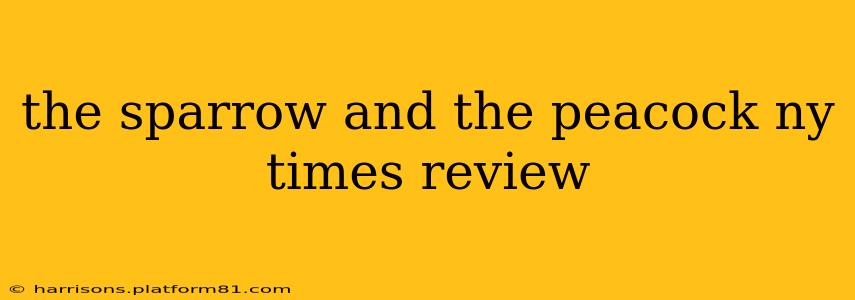The Sparrow and the Peacock: A New York Times Review Deep Dive
The New York Times, a bastion of literary criticism, often features reviews that spark conversations and shape public perception of new books. When a book receives a NYT review, it often signifies a significant achievement in the literary world. This deep dive explores how NYT reviews impact a book's success and examines the potential impact of a hypothetical review of a fictional book titled "The Sparrow and the Peacock." We'll analyze what makes a strong NYT review and how a book's reception can be influenced by the publication's assessment.
While we don't have a real NYT review of "The Sparrow and the Peacock," we can speculate on what such a review might entail and what elements contribute to a compelling and impactful critique.
What Makes a Strong New York Times Book Review?
A compelling NYT book review goes beyond a simple summary of the plot. It delves into the author's style, thematic concerns, and the book's overall impact on the reader. Key elements include:
- Critical Analysis: A strong review doesn't simply praise or condemn the book; it offers insightful analysis of the narrative structure, character development, and the author's use of language. It explores the book's strengths and weaknesses with supporting evidence.
- Contextualization: A good review places the book within its literary context, drawing comparisons to similar works or highlighting its unique contributions to a particular genre. This helps readers understand the book's significance and its place within the broader literary landscape.
- Engagement: A captivating review is engaging and thought-provoking. It uses vivid language and compelling arguments to hold the reader's attention and spark their interest in the book.
- Clarity and Objectivity: While subjective opinions are expected, a strong NYT review maintains a degree of objectivity. It avoids overly enthusiastic praise or harsh criticism without justification. The reviewer supports their claims with textual evidence and logical reasoning.
Hypothetical New York Times Review of "The Sparrow and the Peacock"
Let's imagine a hypothetical NYT review of "The Sparrow and the Peacock," a fictional novel exploring the complex relationship between two contrasting characters. The review might explore themes of societal expectations, personal identity, and the struggle for self-acceptance. A hypothetical excerpt could look like this:
"In 'The Sparrow and the Peacock,' [Author's Name] crafts a richly textured narrative that explores the intricate dance between conformity and individuality. Through the contrasting personalities of Elara, the meticulous sparrow, and Orion, the flamboyant peacock, the author masterfully illuminates the complexities of self-discovery and the societal pressures that shape our identities. The prose is both elegant and accessible, weaving together moments of quiet introspection with bursts of vibrant imagery. While the pacing occasionally lags in the middle section, the powerful conclusion makes it a rewarding, albeit challenging, read."
How NYT Reviews Influence a Book's Success
A positive NYT review can significantly impact a book's success, leading to increased sales, wider readership, and greater visibility. It lends credibility and authority to the work, attracting attention from both readers and other media outlets. Conversely, a negative or lukewarm review can hinder a book's progress, impacting sales and potentially affecting its overall reception. However, it's important to note that the NYT review is just one factor among many contributing to a book's success. Word-of-mouth, marketing efforts, and the book's inherent qualities also play crucial roles.
Frequently Asked Questions (FAQ) – Hypothetical Scenarios based on "The Sparrow and the Peacock"
Q: What genre would "The Sparrow and the Peacock" likely fall under?
A: Depending on the plot specifics, "The Sparrow and the Peacock" could fall under literary fiction, contemporary fiction, or even magical realism if fantastical elements are woven into the narrative. The NYT review would likely identify the appropriate genre and explain how the book fits within that genre's conventions.
Q: What kind of themes might a NYT reviewer focus on in their critique of "The Sparrow and the Peacock"?
A: A reviewer might analyze themes of social expectations versus individual expression, the power of friendship or rivalry, the complexities of identity, and the search for self-acceptance. They could also discuss the author’s use of symbolism, particularly concerning the sparrow and peacock imagery.
Q: How might the NYT reviewer assess the characters' development in "The Sparrow and the Peacock"?
A: The reviewer would likely evaluate the believability and depth of the characters. They'd consider whether the characters undergo significant changes throughout the novel and whether their actions are consistent with their personalities. The reviewer might praise the nuanced portrayals or critique any inconsistencies or lack of development.
In conclusion, the New York Times review holds considerable weight in the literary world. A hypothetical review of "The Sparrow and the Peacock" would be a detailed analysis of its thematic concerns, character development, and writing style, ultimately contributing to shaping the public perception and commercial success of the book.
